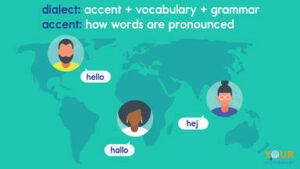 |
| Source: University of Chicago |
Language is, to some extent, hard to be limited in scope since it overlaps with many branches and differs in its functions. But in general, language is a unique social phenomenon. That is to say, any natural language cannot survive on its own without a society. Due to multiculturalism and social mobility, language variation as an issue has attracted many researchers and sociolinguists.
Language variation (or linguistic variation) refers to contextual, social, and regional differences in how a specific language is used by individuals or communities. This article expounds on three major points, namely geographical variation, social variation, and finally contextual variation. But before delving into the discussion of the three major points mentioned above, it is quite necessary to briefly define three main concepts in socio-linguistics so as to avoid ambiguity. These three concepts are: “dialect”, “variety”, and finally “slang”.
1. Key concepts in socio-linguistics
A. “Dialect”
 |
| Source: your Dictionary |
At first, “Dialect” is seen as a geographical subdivision of language. Longman dictionary of language teaching and applied linguistics (fourth edition) defines “dialect as a variety of a language, spoken in one part of a country (regional dialect), or by people belonging to a particular social class (social dialect or sociolect), which is different in some words, grammar, and/or pronunciation from other forms of the same language. A dialect is often associated with a particular accent. Sometimes a dialect gains status and becomes the standard variety of a country.” (p.168)
B. “Variety”
Variety is defined as a set of linguistic items with a similar social variation.
C. “Slang”
With reference to ‘slang’, it is viewed as a restricted set of new words and new meanings of older words mixed with linguistic items with a much larger social distribution.
After defining these terms, it is high time to start discussing the three major elements of linguistic variation:
 |
| Source: Eslforums |
1. Geographical variation
When it comes to geographical variation, it is quite interesting that so many languages in the world have a dialect continuum in which speakers from neighboring dialect areas meet and communicate with each other without problems. Ralph Penny states that geographical variation is a universal characteristic of human language that speakers of the ‘same’ language who live in different parts of a continuous territory do not speak in the same way.
In addition to that, Isogloss is a sociolinguistic phenomenon that plays an important role in building borders between the former varieties and the new ones. Korean language, for instance, is based on two characteristics: the “Abstrand” language and Turkic as “Ausbau” language. The Abstrand language shows the independence of a specific language. On the other hand, Asubau languages demonstrate the amalgams of languages within one geographical area.
2. Social Variation
As far as social variation is concerned, societies are approached from two different views. The first one is a social network and the second one is social ratification. With reference to social networks, it is mandatory to point out the density of networks in which everyone knows everyone else, and secondly the multiplexity network that requires two individuals interacting less than in the dense network. This article then draws a distinction between jargon and slang. The latter is very informal and could include impolite words, whereas jargon is seen as a set of vocabulary items used by members of a particular profession.
3. Contextual variation
The last major point in the article is contextual variation. It is a variation within the individual, that is to say, we all vary our language between contexts. In clarifying the contextual variation, it is quite interesting that we take into account language policy and how it makes countries choose the three different levels of language, namely official language, the national language, and at last local language.
To sum up, it is an outstanding thing to see how humans use different language variations, and how individuals are able to refine their own way of speaking according to regional and social purposes. It is also fascinating that some regions consist of more than three hundred languages and have various linguistic items.
If you think these tips are useful, please “SHARE AND CARE”







